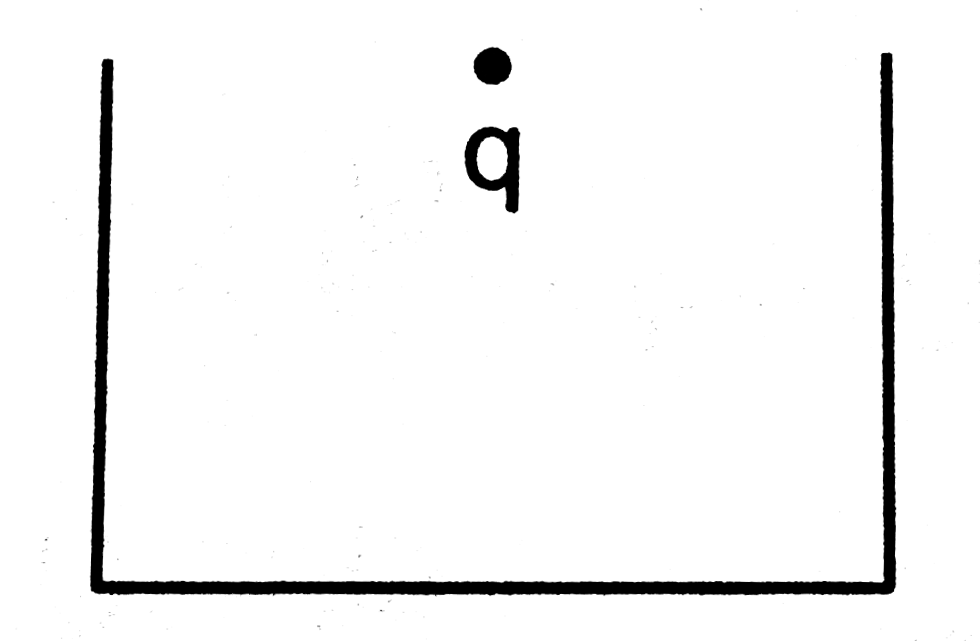A charge Q is uniformly distributed over a rod of length ι. Condider a hypothetical cube of edge ι with the centre of the cube at one end of the rod. Find the minimum possible flux of the electric field through the entire surface of the cube.
To solve the problem, we will follow these steps:
Step 1: Understand the Configuration
We have a rod of length L with a total charge Q uniformly distributed along its length. We consider a cube of edge length L whose center is located at one end of the rod. This means that half of the cube (length L/2) extends into the rod.
Step 2: Determine the Charge Density
The linear charge density λ of the rod can be calculated as:
λ=QL
This represents the amount of charge per unit length along the rod.
Step 3: Calculate the Charge Enclosed by the Cube
Since the cube extends into the rod by L/2, we need to find the charge enclosed within this length. The charge enclosed Qenclosed can be calculated as:
Qenclosed=λ⋅(L2)=QL⋅(L2)=Q2
Step 4: Apply Gauss's Law
According to Gauss's Law, the electric flux Φ through a closed surface is given by:
Φ=Qenclosedϵ0
Substituting the value of Qenclosed:
Φ=Q2ϵ0=Q2ϵ0
Step 5: Conclusion
The minimum possible electric flux through the entire surface of the cube is:
Φ=Q2ϵ0
We have a rod of length L with a total charge Q uniformly distributed along its length. We consider a cube of edge length L whose center is located at one end of the rod. This means that half of the cube (length L/2) extends into the rod.
The linear charge density λ of the rod can be calculated as:
λ=QL
This represents the amount of charge per unit length along the rod.
Since the cube extends into the rod by L/2, we need to find the charge enclosed within this length. The charge enclosed Qenclosed can be calculated as:
Qenclosed=λ⋅(L2)=QL⋅(L2)=Q2
According to Gauss's Law, the electric flux Φ through a closed surface is given by:
Φ=Qenclosedϵ0
Substituting the value of Qenclosed:
Φ=Q2ϵ0=Q2ϵ0
The minimum possible electric flux through the entire surface of the cube is:
Φ=Q2ϵ0
Topper's Solved these Questions
Similar Questions
A charge Q is placed at the centre of a cub. Find the flux of the electric field through the six surfaced of the cube.
View SolutionA Charge Q is distributed uniformly on a ring of radius r. A sphere of equal r is constructed with its centre at the periphery of the ring (figure 30.12) Find the flux of the electric field through the surface of the sphere.

View Solution
Knowledge Check
A charge q is placed at the centre of the open end of a cylindrical vessel . The flux of the electric field through the surface of the vessel is
 AzeroBqε0Cq2ε0D2q2ε0.
AzeroBqε0Cq2ε0D2q2ε0.A long string with a charge of a per unit length passes through an imaginary cube of edge L. The maximum possible flux of electric field through the cube will be
AλLε0B√2λLε0C√3λLε0D√5λLε0A charge Q is situated at the corner of a cube the electric flux passed through all the six faces of the cube is :
AQ6∈0BQ8∈0CQ∈0DQ2∈0
A charge q is placed at the centre of a cube of side l what is the electric flux passing through two opposite faces of the cube ?
View SolutionFigure shown an imaginary cube of edge L/2. A uniformly Charged rod of length L moves towards left at a small but constant speed v. At t=0, the left end just touches the centre of the cube opposite it. Which of the graphs shown in figure represents the flux of the electic field through the cube as the rod goes through it?

View SolutionA chrage 'q' is placed at the centre of a cube of side 'l' . What is the electric flux passing through each face of the cube?
View SolutionA charge q is located at the centre of a cube. The electric flux through any face is
View SolutionA charge Q is situated at the corner of a cube, the electric flux passing through all the six faces of the cube is :
View Solution
